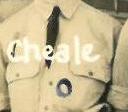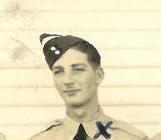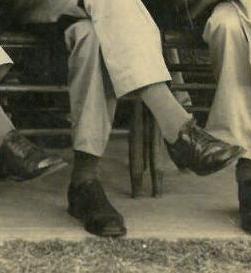During the second world war the RAF found training sufficient pilots to be problematic. Trainee pilots needed space to practice, free from the risk of enemy aircraft attacking them before they were proficient. Airfields were also in short supply as priority went to operational squadrons. With this in mind, the RAF sent its new pilot recruits to training facilities in the safe skies of Rhodesia, Canada and the USA. Six British Flying Training Schools were set up, No1 School opening in Terrell, Texas on 9th June 1941. This photograph shows one of the cohorts of RAF pilot cadets and their instructors trained at the base: As can be seen the cadets wear USAAF uniforms rather than traditional RAF uniforms:
As can be seen the cadets wear USAAF uniforms rather than traditional RAF uniforms: These would have been more practical than their heavy woollen uniforms in the hot Texas sun. They do however retain their black RAF ties:
These would have been more practical than their heavy woollen uniforms in the hot Texas sun. They do however retain their black RAF ties: And RAF FS caps with the white flash of an officer cadet:
And RAF FS caps with the white flash of an officer cadet: These cotton uniforms are worn with socks and shoes:
These cotton uniforms are worn with socks and shoes: And a US style belt:
And a US style belt: The instructors are dressed the same, but have khaki ties:
The instructors are dressed the same, but have khaki ties: The instructors wear crusher caps with a distinctive, non military, badge:
The instructors wear crusher caps with a distinctive, non military, badge: This photograph was presumably taken at the start of the course and some of the pilots are marked with ‘X’ or ‘O’, indicating their fate on the course. The rear of the photograph has a photographer’s stamp for a local firm in Dallas Texas:
This photograph was presumably taken at the start of the course and some of the pilots are marked with ‘X’ or ‘O’, indicating their fate on the course. The rear of the photograph has a photographer’s stamp for a local firm in Dallas Texas: The British Flying Training Schools had a small RAF staff, with the instructors, ground crew and support personnel made up of US Civilians, the aircraft were supplied by the USAAF. Training took 28 weeks, primary training on Stearman PT17s, Basic training on Vultee BT13s and advanced training on North American AT6As. In total over 18,000 RAF cadets went through the training scheme at the six schools in the USA. Mike Igglesden was one of those sent to the US, being assigned to No6 British Flying Training School:
The British Flying Training Schools had a small RAF staff, with the instructors, ground crew and support personnel made up of US Civilians, the aircraft were supplied by the USAAF. Training took 28 weeks, primary training on Stearman PT17s, Basic training on Vultee BT13s and advanced training on North American AT6As. In total over 18,000 RAF cadets went through the training scheme at the six schools in the USA. Mike Igglesden was one of those sent to the US, being assigned to No6 British Flying Training School:
In late August 1942 I, with many other aircrew under training, left the Air Crew Despatch Centre at Heaton Park, Manchester, for Gourock. There we embarked in an American troopship, the “Thomas H Barry”, for an Atlantic crossing. She had been designed for the Caribbean and was not the ideal length for the Atlantic seas; this led to a good deal of what might euphemistically be called discomfort among the passengers. I volunteered to work in the galley (giving the benefit of fresh-water rather than sea-water showers) and turned out to be impervious to seasickness. On arrival in New York, we had the exciting experience of travelling by train through the ‘dim-out’ – bright to our eyes – of coastal USA and Canada to Moncton in New Brunswick. After a couple of weeks at No. 31 Personnel Depot there, another rail journey took us to our destinations, by regular express trains rather than the troop-carrying superannuated Canadian stock used for the trip to Canada.
For 50 of us, the destination was No. 6 British Flying Training School (BFTS), Ponca City in Oklahoma, where we were to stay for 6 months, becoming Course No. 10. Other than knowing that the mid-West was a centre of isolationism, portending some opposition to the Brits, we knew nothing of the place. On arrival, however, we found nothing but the kindest of welcomes from the citizens, leading to friendships that last until this day.
Update
Adrian Fett Has kindly been in contact and provided an interesting analysis which readers might like to consider:
Some observations on this photo and your interpretation of it:
1. The chaps you take to be instructors are arranged in the same alphabetical order as the rest of the course so are more likely to be fellow pilots under training. Their uniform is that of a USAAF pilot/aircrew trainee with the large winged propeller cap badge and shirt collar dogs. They wear the USAAF issue belt with polished metal slide buckle. Davis is marked with an ‘x’ on the photo – we wouldn’t expect an instructor to fail the course!
2. This is one of two or even three photos of the trainees of this course intake showing only those with surnames starting A to J.
3. Did the white flash on the RAF forage cap indicate ‘officer cadet’ or rather pilot/aircrew under training? Remember that many RAF pilots were sergeants in WW2.
4. The annotation ‘x’ I assume indicates that the trainee failed the course so what does ‘o’ mean? Most failed pilots obviously had the aptitude to be aircrew or they wouldn’t have been selected for pilot training. Many went on to take on other aircrew roles so perhaps Observer? Or perhaps they passed and were selected to be Officers.
5. Saving the most significant one to last – ‘Coaster’ has both an ‘x’ and the only ‘k’ on the photo. Killed? Many pilots were killed in training. Putting the surname Coaster into the CWGC site gets you just one result. LAC Kenneth William Coaster 1803392 RAFVR who died on 17/09/1943 and is buried at Terrell (Oakland) Memorial Park, Texas. This cemetery contains 20 graves of RAF personnel killed in training at the nearby 1BFTS between November 1941 and September 1945. He was just 19 and the son of Alfred and Ethel Coaster of Hayes, Middlesex. How many more of these brave young chaps failed to make it to the end of the war I wonder.
Many Thanks Adrian for these insights.
Reblogged this on The Continuing Adventures of Falstaff Wild and commented:
A throughly good report – never heard of airmen talking about Texas, but they enjoyed being over there!
Some observations on this photo and your interpretation of it:
1. The chaps you take to be instructors are arranged in the same alphabetical order as the rest of the course so are more likely to be fellow pilots under training. Their uniform is that of a USAAF pilot/aircrew trainee with the large winged propeller cap badge and shirt collar dogs. They wear the USAAF issue belt with polished metal slide buckle. Davis is marked with an ‘x’ on the photo – we wouldn’t expect an instructor to fail the course!
2. This is one of two or even three photos of the trainees of this course intake showing only those with surnames starting A to J.
3. Did the white flash on the RAF forage cap indicate ‘officer cadet’ or rather pilot/aircrew under training? Remember that many RAF pilots were sergeants in WW2.
4. The annotation ‘x’ I assume indicates that the trainee failed the course so what does ‘o’ mean? Most failed pilots obviously had the aptitude to be aircrew or they wouldn’t have been selected for pilot training. Many went on to take on other aircrew roles so perhaps Observer? Or perhaps they passed and were selected to be Officers.
5. Saving the most significant one to last – ‘Coaster’ has both an ‘x’ and the only ‘k’ on the photo. Killed? Many pilots were killed in training. Putting the surname Coaster into the CWGC site gets you just one result. LAC Kenneth William Coaster 1803392 RAFVR who died on 17/09/1943 and is buried at Terrell (Oakland) Memorial Park, Texas. This cemetery contains 20 graves of RAF personnel killed in training at the nearby 1BFTS between November 1941 and September 1945. He was just 19 and the son of Alfred and Ethel Coaster of Hayes, Middlesex. How many more of these brave young chaps failed to make it to the end of the war I wonder.
Thanks Adrian for these excellent insights, I have added them to the body of the blog post as I worry they will get overlooked down here in the comments section.